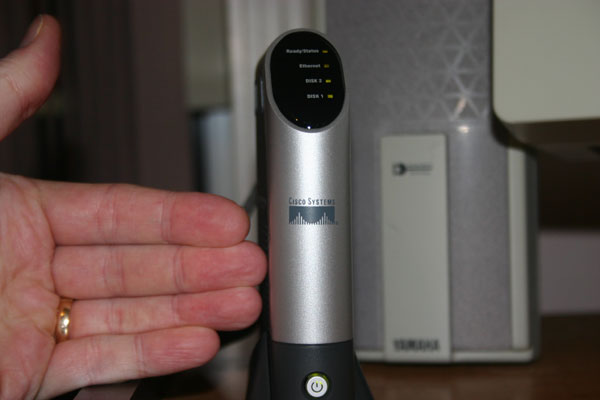I’ve started on my 2006 computer upgrade process. The first thing I wanted to get done was to set up network storage for backup and file sharing on my home network. I’m forever rebuilding computers, so anything that looks like a full-blooded computer ends up disconnected or “changed” too often. So I decided some months ago that I’d get a dedicated “network storage” device.
What I settled on is the Linksys Network Storage Link (NSLU2). Like most of these devices, it has a processor, a network interface, and a couple of USB 2.0 ports on the back to hook up USB- based hard drives. It doesn’t have any storage of its own- some of the others do.
The NSL intrigued me for several reasons, not the least of which is that inside this little box is a Linux based computer. This means there are all sorts of people playing with the innards of the box and hacking it to do different things. Its also tiny and kind of cute:
Yep, that’s my hand beside it there. The drives I attached to it are each about the same physical size: I stacked them under the NSL- they connect up with a standard USB cable, so there is some flexibility there. Configuring the NSL is a breeze and, contrary to the included documentation, you can attach and access FAT/NTFS formatted drives, but only if you upgrade to the latest firmware. With the old firmware, any drive you attached had to be formatted with a Linux file system, EXT3: you still need a drive formatted this way if you want access to some of the NSL’s features like users, groups, and dedicated shares/mount points.
The NSL basically looks like a Windows based computer on your network with some file shares available. Performance is about what you’d expect for a network based drive: somewhat under 10 MBps (megabytes per second) which, if you do the math, means its pumping data about as fast as you conceivably can on a 100 Mbps (megabit per second) Ethernet LAN. I haven’t experimented much with security, but you can create users and private shares on the device, assuming you have at least one EXT3 formatted hard drive.
The two drives I attached are pretty ordinary: one is a “no-name” 250 GB USB 2.0 drive I picked up at Best Buy for $249, the other is a 300 GB HP drive Irene bought for me at London Drugs for $349. The HP drive is somewhat better built- cast aluminum chassis instead of pressed aluminum, and it has a tiny 1 cm fan in the back for cooling. Its a bit amazing to realize I have over half a terabyte of storage attached to this configuration. That translates into 275,000,000 written pages of text, about 600 hours of DVD quality video, or two copies of the latest EverQuest 2 update… 😉
Technorati Tags: Linksys, Network Storage, NSLU2


Hmm, it looks pretty nice 🙂 I think Linksys products improved tremendously since they were bought out by Cisco… How much did you pay for the device? People who already have a few USB external drive may be better using that thing, but if they don’t, I think a complete NAS solution could be more advantageous.. There are a few that are quite cheap..
Kiltak
[Geeks Are Sexy] Tech. News
The Linksys NSL was $129. This compares favorably to some network storage devices with built-in storage I looked at- they were in the $300 price range with a 160 GB drive. A 160 GB drive seems to sell in the $150 price range or thereabouts now, so…comparable.
The main advantage I saw to keeping the USB drive as a “separate” thing is that it means that I can always buy a different network storage device down the road and the storage is still useful. There are advantages to both designs though.
Pingback: Network attached storage- ReadyNAS NV+ and NVX | Kelly's World- A View into the mind of Uber Geek, Kelly Adams